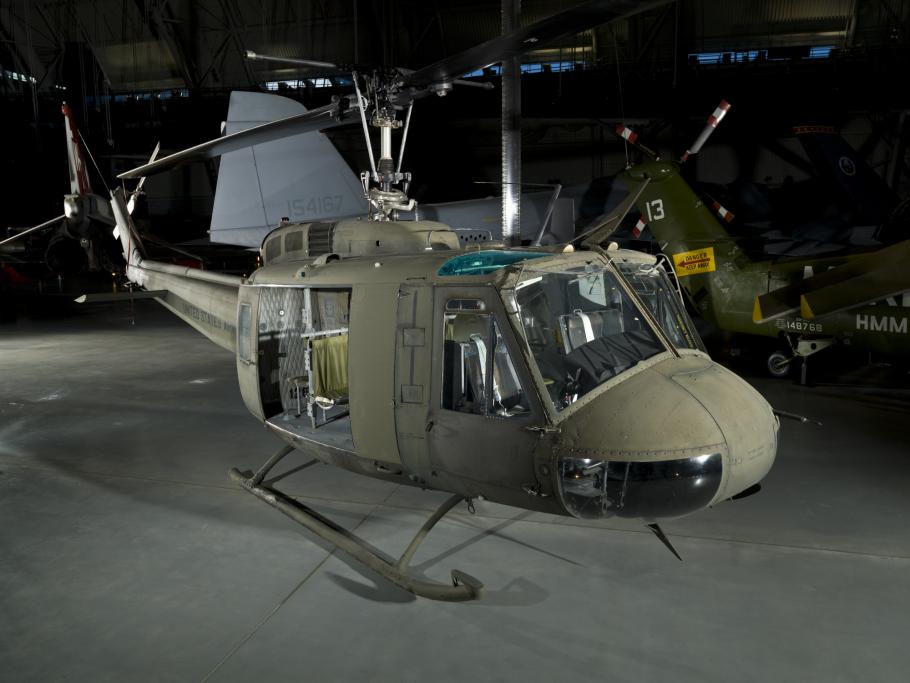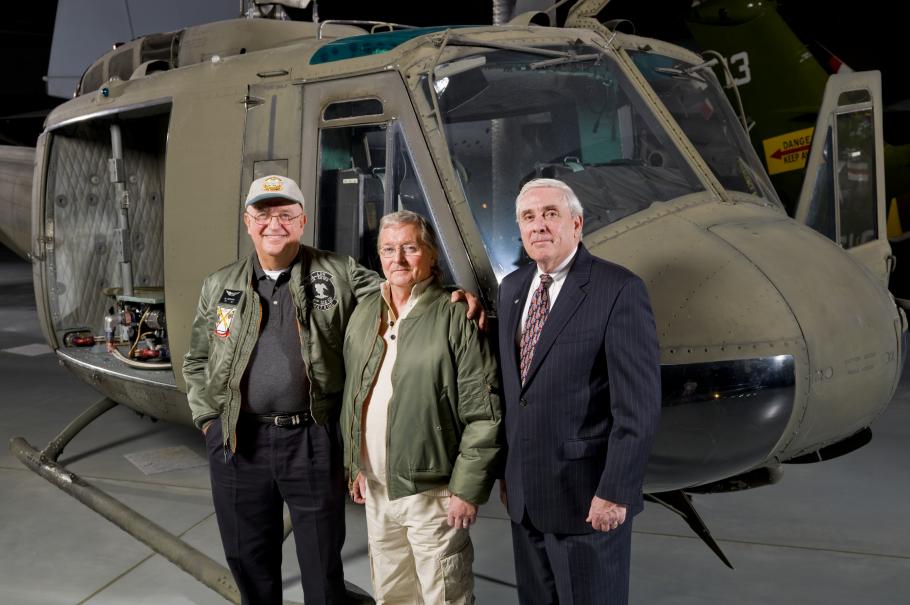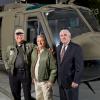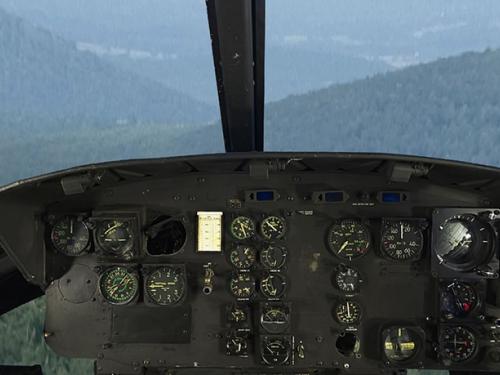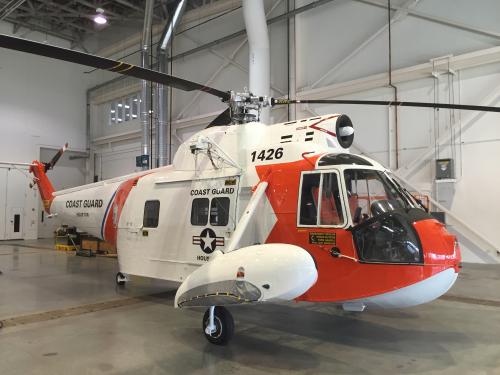What the jeep was to Americans during World War II, so was the Huey to those who fought in Vietnam. All branches of the U. S. military operated them and they ranged to every corner of South Vietnam and into Cambodia and Laos. The term 'Huey' originated in the U. S. Army as a derivative of the original designation HU-1A - Helicopter, Utility, Model 1A. For a time, the Huey was one of the most recognizable aircraft in history. People knew it not just on sight but by sound, too. They usually heard the unmistakable whop-whop-whop of the main rotor blade long before they saw a Huey.
The concept for this aircraft sprang from the cold, muddy battlefields of the Korean War, where the original MASH (Mobile Army Surgical Hospital) helicopter, the Bell 47, recovered thousands of wounded soldiers and delivered them straight to critical care units. In 1954 the U. S. Army launched a design competition for a new medical evacuation (medevac) helicopter. The Army specifications described an aircraft that weighed 3,600 kg (8,000 lb), fully loaded. It could carry a payload of 360 kg (800 lb) a distance of at least 365 km (227 miles) and cruise at 184 kph (114 mph). The helicopter could climb to a service ceiling of 1,824 m (6,000 ft).
Bell Helicopter Corporation enjoyed several advantages in competing for this contract. The Army held the company in high regard, based on the excellent service rendered by the piston engine-powered Bell 47 during the Korean War. Bell was already flying an H-13D equipped with a French-designed, American-made, Continental XT-51 gas turbine engine. Bell called this modified H-13D test aircraft the Bell Model 201 but the Army gave it the designation XH-13F. The turbine engine represented a revolutionary step in the development of helicopters, and the Army saw it as a critical component in the new medevac helicopter design. Compared to the reciprocating piston engine, the turbine was lighter, smoother, easier to maintain, and much more reliable.
Testing the H-13D gave Bell the confidence to incorporate a turbine engine in the Army's new transport helicopter design. At about the same time, the Lycoming Company was developing the XT-53 engine with Army backing. Lycoming had not designed this engine for a specific application but Bell engineers saw great potential in this power plant. They joined with Lycoming to develop the XT-53 to Bell Helicopter specifications, and this new engine eventually powered the prototype Huey. The Army designated this prototype the XH-40 and the first one flew on October 22, 1956. It performed so well that Bell earned a contract to produce three more prototypes in February 1955. Tests on these helicopters (Bell Model 204) were successful and Bell and the Army signed a contract to build 200 production medevac versions plus 100 outfitted as instrument trainers to teach pilots to fly at night and in bad weather.
Flight tests revealed no significant problems with the prototypes and production began in September 1958 when the first of 182 Model 204s rolled off the assembly line. The new aircraft was designated HU-1A (hence the nickname 'Huey') and officially christened the Iroquois, in keeping with the Army tradition of naming helicopters after American Indian tribes. In 1962 the Army aircraft designation system changed and the HU-1 became the UH-1, but the Huey nickname remained.
In 1960 representatives from Bell Helicopter met with U. S. Army General Hamilton Howze. The general was promoting the idea of moving Army infantry around the battlefield using helicopters rather than trucks. United States Marines of the Marine Helicopter Squadron HMX-1 first conceived of and tested the concept of moving troops with helicopters in 1948 along the coast of North Carolina.
In 1962 General Howze was put in charge of a board formed to consider and test new tactical theories. During these trials, Howze used Hueys to demonstrate the ease of moving a company of infantry (about 100 soldiers) across a river or over rough terrain. He argued that the Army's two airborne divisions - the 82nd and the 101st - needed this capability because both units were designed to move quickly to counter battlefield threats. Based on his recommendations, the Army created the 11th Air Assault Division to test Howze's theories. The results led the Army to fundamentally change the way it rode into battle and the service introduced a new type of warfare several years later on the other side of the world - Vietnam.
The first Hueys to operate in Vietnam were medevac HU-1As that arrived in April 1962, before the United States became officially involved in the conflict. These Hueys supported the South Vietnamese Army, but American crews flew them. In October, the first armed Hueys, equipped with 2.75-inch rockets and .30 caliber machine guns, began flying in Vietnam. The main role of these Huey 'gunships' was to escort Army and Marine transport helicopters. By the end of 1964, the Army was flying more than 300 'A and 'B model Hueys.
During the next decade, the Huey was upgraded and modified based on lessons learned in combat. The UH-1D entered service in 1965 with a wider main cabin, a higher gross weight, and more powerful engine, although at high altitudes in the humid climate of Vietnam, it still lacked sufficient power for some missions. In early 1967, the Army accepted its first UH-1H Huey. This was the last major Huey upgrade. It appeared identical to the UH-1D but beneath the engine cowling, Bell installed the improved Lycoming T53-L-13 engine. At last, the Huey had enough power to handle almost any mission in the harsh conditions of Vietnam. The H Model was equipped with a 1,400 hp T53-L- 13B engine and it had 623 cubic meters (220 cu. ft.) of cargo space. It could carry up to 1,814 kg (4,000 lb) on its cargo hook or an equal load internally. A 833.8-liter (220-gallon) fuel tank gave the Huey a range of 459 km (285 miles) with an extended range of 1,094 km (680 statute miles) with auxiliary tanks installed. The Huey mission portfolio now covered troop transport, medevac, gunship, smoke ship, command and control, general service and support, and reconnaissance, and all branches of the U. S. military flew them.
It was in Vietnam that Army and Marine soldiers first tested the new tactics of airmobile warfare. In a typical air assault mission, Huey helicopters inserted infantry deep in enemy territory. Huey gunships, equipped with machine guns, rockets, and grenade launchers, often escorted the transports. The Hueys carrying troops were nicknamed "slicks" because they were not cluttered with rockets or guns mounted externally. As the slicks approached the landing zone, or LZ, the gunships swooped down and sprayed rockets and machine gun fire into areas that might conceal enemy forces. Some Hueys, including the aircraft now in the NASM collection, carried equipment to generate a thick cloud of smoke. Smoke was deployed between the LZ and suspected enemy positions to protect the slicks and their valuable cargo. As the Hueys laden with troops touched down, door gunners aboard the slicks fired machine guns to help cover the soldiers as they jumped to the ground. In seconds, the troops cleared the aircraft and the pilots accelerated up and away as quickly as possible to clear the LZ to make room for other slick approaching the LZ. Within minutes, helicopters could insert entire battalions into the heart of enemy territory - this was airmobility.
The Huey became a symbol of U.S. combat forces in Vietnam and millions of people worldwide watched it fly in TV news reports. At its peak in March 1970, the U.S. military operated more than 3,900 helicopters in the war in Vietnam and two thirds of them were Hueys. Their impact was profound, not only in the new tactics and strategies of airmobile operations, but on the survival rate of battlefield casualties. U.S. Army patients made up 390,000 of the total number of people transported by medevac helicopters in Southeast Asia. Almost a third of this total (120,000) were combat casualties. The Huey airlifted ninety percent of these casualties directly to medical facilities.
During World War II, twenty-nine percent of all wounded U.S. soldiers died. Advances in medical technology and the medevac helicopter reduced that number to twenty-six percent during the war in Korea. In Vietnam, the percentage of soldiers who died from wounds sustained in combat fell to nineteen percent, about a twenty-five percent drop from the Korean War fatality rate. Perhaps a more compelling statistic is the total numbers of people transported by medevac helicopters, nearly 900,000 in Vietnam compared to 17,700 in Korea.
A final statistic to consider is the number of soldiers who died from their wounds after reaching medical facilities. During the war in Vietnam, this figure actually rose by .1 percent compared to the 2.5 percent who died in Korea. This in no way reflects poorly on the medical care that soldiers received in Vietnam, but on the contrary, it highlights the speed and dedication of medevac crews to move even the most critical patients from battlefield to hospital. These brave crews gave the wounded a chance not available in past conflicts.
Hueys have served in every branch of the American military and 34 other nations as well. More UH-1H Hueys were built than any other helicopter subtype. More than 5,500 were built before production ended in 1982. Only a few other American aircraft have ever become so prized. To meet the demand for the UH-1 abroad, Bell sold production rights to Italy, Germany, Taiwan and Japan. Bell and its licensees built more than 16,000 helicopters in the Huey family, including the Huey Cobra gunship variant (Cobras used the same rotors, engine, and transmission system as the UH-1). These figures put the Huey series second, behind the Consolidated B-24 Liberator, as the most-produced American military aircraft in history. Today, several hundred Huey helicopters remain in active service in the U.S. Army, Army National Guard, with the U. S. Marines and the U. S. Air Force, as well as several foreign countries. The Huey can be added to the small list of aircraft that have remained in active military service for more than three decades.
The National Air and Space Museum acquired a UH-1H Huey in 1995. This aircraft, U.S. Army serial number 65-10126, began its military career as a brand new UH-1D accepted by the Army in October 1966. One month later, 65-10126 was flying in Vietnam with Company A of the 229th Aviation Battalion, 1st Cavalry Division. It remained in Company A for ten months before the Army transferred the helicopter to Headquarters Company, 11th Aviation Battalion, where it served through June 1968 as Smokey III, a name given to the aircraft by its crew. These particular Hueys were fitted with a device that produced dense smoke by spraying oil into the exhaust system. The smoke screened friendly helicopters from the enemy. For example, as troop transports approached an LZ, a Smokey would fly very low, producing smoke, between the LZ and known or suspected enemy positions. The operation worked best when the smoke was deployed low and slow. This made flying the smoke ships an especially risky mission.
In July 1968, 65-10126 began a third combat tour in Vietnam. Pilots in the 128th Assault Helicopter Company flew it until April 1969 when the Army returned the Huey to the United States for repair and overhaul. In October, the aircraft went back to Vietnam for a fourth combat tour and the Army assigned it to the 118th Assault Helicopter Company. This unit operated the helicopter in combat through April 1970. After nearly four years of combat service and more than 2,500 combat flying hours, the aircraft was extensively damaged in an accident. The Army sent the Huey to Corpus Christi, Texas, for a total overhaul. It remained there until May 1971 when it was reassigned to the Army National Guard. For a time, the Huey flew in Kentucky and North Carolina. In March 1977, Bell converted the helicopter into an H-Model Huey and the Guard continued to fly it until February 1994. It retired from flight status after flying more than 6,500 flight hours. The U. S. Army Aviation Museum, Fort Rucker, Alabama, stored it until the National Air and Space Museum acquired the aircraft in 1995 and moved it to the Paul E. Garber Restoration Facility. This important American aircraft is now on public display at the Steven F. Udvar-Hazy Center.
